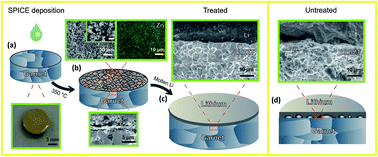当前位置:
X-MOL 学术
›
Sustain. Energy Fuels
›
论文详情
Our official English website, www.x-mol.net, welcomes your
feedback! (Note: you will need to create a separate account there.)
A surfactant-assisted strategy to tailor Li-ion charge transfer interfacial resistance for scalable all-solid-state Li batteries†
Sustainable Energy & Fuels ( IF 5.0 ) Pub Date : 2018-07-18 00:00:00 , DOI: 10.1039/c8se00234g Chengtian Zhou 1, 2, 3, 4 , Alfred Junio Samson 1, 2, 3, 4 , Kyle Hofstetter 1, 2, 3, 4 , Venkataraman Thangadurai 1, 2, 3, 4
Sustainable Energy & Fuels ( IF 5.0 ) Pub Date : 2018-07-18 00:00:00 , DOI: 10.1039/c8se00234g Chengtian Zhou 1, 2, 3, 4 , Alfred Junio Samson 1, 2, 3, 4 , Kyle Hofstetter 1, 2, 3, 4 , Venkataraman Thangadurai 1, 2, 3, 4
Affiliation

|
Solid-state batteries with Li anode present a promising design to achieve high energy density and safe batteries that meet today's growing demands for portable electronics, electric vehicles, and grid-scale energy storage. Garnet-type solid Li-ion electrolytes exhibit desired physical and chemical properties, including high total (bulk + grain-boundary) Li-ion conductivity, chemical stability with elemental Li, and high electrochemical stability window (6 V vs. Li+/Li), which make them a unique candidate membrane for all-solid-state batteries. A significant challenge with all-solid-state batteries is the high area specific resistance (ASR) in the solid electrolyte/Li anode interface. Although a substantial reduction in interfacial ASR has been achieved recently with Li-stuffed garnets and Li anode, the equipment and techniques used present massive challenges in both cost-effectiveness and scalability. Here, we show a surfactant-assisted wet chemical method to deposit a ZnO layer on Li-stuffed Li6.5La2.9Ba0.1Zr1.4Ta0.6O12 (LLBZT) that increases the contact area between Li/LLBZT and reduces interfacial ASR from 70 to 10 Ω cm2 at room temperature. Microstructural analysis reveals the uniform distribution of nano ZnO, which causes an excellent Li wetting on the garnet electrolyte and improvement in the contact area between the electrolyte and electrode. Electrochemical characterization and galvanostatic cycling confirm stable Li plating/stripping for more than a hundred cycles at 0.1 mA cm−2, demonstrating a compelling strategy to solve the Li/solid electrolyte interface problem in all-solid-state Li batteries.
中文翻译:

表面活性剂辅助策略可定制可伸缩全固态锂电池的锂离子电荷转移界面电阻†
带有锂阳极的固态电池提出了一种有前途的设计,可以实现高能量密度和安全的电池,可以满足当今对便携式电子产品,电动汽车和电网规模储能的不断增长的需求。石榴石型固体锂离子电解质表现出所需的物理和化学性质,包括高的总(体相+晶界)锂离子电导率,具有元素锂的化学稳定性以及高的电化学稳定性窗口(6 V vs. Li +/ Li),这使它们成为全固态电池的独特候选膜。全固态电池面临的重大挑战是固态电解质/锂阳极界面中的高面积比电阻(ASR)。尽管最近用锂填充石榴石和锂阳极已实现界面ASR的大幅降低,但所使用的设备和技术在成本效益和可扩展性方面都提出了严峻挑战。在这里,我们展示了一种表面活性剂辅助湿法化学方法,该方法可在填充锂的Li 6.5 La 2.9 Ba 0.1 Zr 1.4 Ta 0.6 O 12(LLBZT)上沉积ZnO层,从而增加了Li / LLBZT之间的接触面积并使界面ASR从70降低至10Ωcm 2在室温下。微观结构分析显示出纳米ZnO的均匀分布,这导致石榴石电解质上极好的Li润湿性,并改善了电解质与电极之间的接触面积。电化学表征和恒电流循环证实了在0.1 mA cm -2的锂电镀/剥离稳定了100个周期以上,这证明了一种解决全固态Li电池中Li /固体电解质界面问题的引人注目的策略。
更新日期:2018-07-18
中文翻译:

表面活性剂辅助策略可定制可伸缩全固态锂电池的锂离子电荷转移界面电阻†
带有锂阳极的固态电池提出了一种有前途的设计,可以实现高能量密度和安全的电池,可以满足当今对便携式电子产品,电动汽车和电网规模储能的不断增长的需求。石榴石型固体锂离子电解质表现出所需的物理和化学性质,包括高的总(体相+晶界)锂离子电导率,具有元素锂的化学稳定性以及高的电化学稳定性窗口(6 V vs. Li +/ Li),这使它们成为全固态电池的独特候选膜。全固态电池面临的重大挑战是固态电解质/锂阳极界面中的高面积比电阻(ASR)。尽管最近用锂填充石榴石和锂阳极已实现界面ASR的大幅降低,但所使用的设备和技术在成本效益和可扩展性方面都提出了严峻挑战。在这里,我们展示了一种表面活性剂辅助湿法化学方法,该方法可在填充锂的Li 6.5 La 2.9 Ba 0.1 Zr 1.4 Ta 0.6 O 12(LLBZT)上沉积ZnO层,从而增加了Li / LLBZT之间的接触面积并使界面ASR从70降低至10Ωcm 2在室温下。微观结构分析显示出纳米ZnO的均匀分布,这导致石榴石电解质上极好的Li润湿性,并改善了电解质与电极之间的接触面积。电化学表征和恒电流循环证实了在0.1 mA cm -2的锂电镀/剥离稳定了100个周期以上,这证明了一种解决全固态Li电池中Li /固体电解质界面问题的引人注目的策略。











































 京公网安备 11010802027423号
京公网安备 11010802027423号